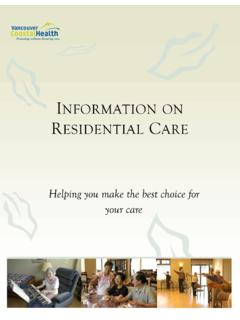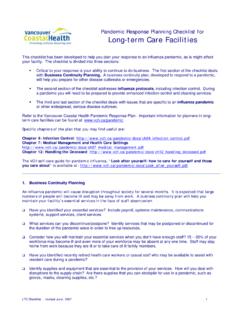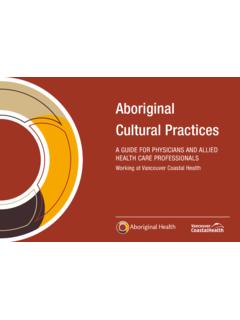Transcription of prepare to care child care - Vancouver Coastal Health
1 child careprepare to careAn Emergency Preparedness Guide for child ACKNOWLEDGEMENTS Many thanks to all of the great sources for emergency preparedness information and expertise used in creating the guide, in particular the City of Richmond Emergency Management Office, North Shore Emergency Management Office, Provincial Emergency Program and the Snohomish Health District. The cover image is a view of Hurricane Isabel, 2003, by a student of the Texie Camp Marks Children s Centre. Courtesy of FEMA: 1 TABLE OF CONTENTS 3 ASSESS & 4 PREVENT & 7 Emergency 9 Emergency 15 18 RESPOND & 22 Response 22 25 28 Lockdown 30 Loss of 32 37 EDUCATE and 40 EXERCISE and 41 44 Local and 44 Provincial and 45 Additional 46 2 INTRODUCTION Planning and preparing can lessen the impact of emergencies and disasters on the Health and safety of staff and children, your child care facility and its operations.
2 This guide is designed to not only help child care providers meet the new emergency management specifications in the BC child care Licensing Regulation, but to take your emergency preparedness program far beyond the plan. It provides information to help you prepare an emergency program and plan, to implement and sustain them long-term. Forms and procedures labelled as Plan Template, which are available digitally, are designed to be customized to create an emergency plan to suit your unique situation. All the information in this document is for your use paraphrase, plagiarize and make the information your own.
3 The only thing we ask in return is for you to help us make it better. To provide feedback on this guide, please email 3 ASSESS & EVALUATE Being prepared for an emergency means having more that an emergency plan on a shelf it s about ensuring staff and parents are personally prepared, understand their role during an emergency, and have an opportunity to train and practice. It s about maintaining a program of readiness. As illustrated below, developing your emergency preparedness program is a continual process of: assessing the hazards and your related risk; evaluating the success of your program in meeting those demands; preventing injuries and damage through hazard mitigation or preparing your environment; preparing your emergency supplies and plan to address response and recovery, educating and training staff, parents and children and exercising and testing your plan, supplies and equipment to ensure they will work when needed.
4 Assess & EvaluatePrevent & PrepareEducate & Train Exercise & Test Exercise staff, parents &children, test equipment,and maintain suppliesEducate & train staff, parents &children on the plan &response proceduresAssess the program annually and following exercises & responses to emergencies Prevent injuries & damage, develop the plan & prepare the environment 4 The Program Involve key stakeholders in the process of developing your program. If you operate a family child care , involve your family, friends and neighbours. If you operate a child care facility or preschool in leased space, a community centre or school, work with the administrator or property management for that facility.
5 Key steps in developing your program include: Conducting a site hazard assessment to identify and prioritize issues to be resolved and mitigate the risk Gathering, storing and maintaining emergency supplies Developing the plan to include, as a minimum, roles and responsibilities key contacts, response procedures and facility map Determine alternative modes of communication Determining evacuation routes, meeting place and re-location sites Learning how to protect yourself and children during an earthquake and other emergencies, manage utilities.
6 Evacuate and shelter in place Implementing the plan by providing opportunities for education, training and exercises Continually assess and evaluate your program to reflect on progress, changes to your facility or operations, new or changing threats and hazards, lessons learned during exercises and the experience of actual emergencies. 5 6 TEMPLATE: Program Assessment As a minimum complete a program assessment once a year, and following exercises and actual Status Comments Assigned To Date Completed Prevention & Preparedness Site Hazard Assessment Mitigate Non-Structural & Structural Hazards Complete Hazard Hunt Form Emergency Plan Roles & Responsibilities Communications Directory Facility Map and Evacuation Plans Current & Posted Response Procedures Emergency Supplies Current & Maintained Children s Emergency Records Current & Maintained Alternative Communication Training & Exercises Conduct Plan Orientation
7 Sessions for Staff & Parents & a Walkabout Drill Conduct Ongoing Emergency Education & Training to Staff & Parents Conduct Monthly Drills - Incorporate Various Procedures Sheltering & Earthquake Response Conduct of Emergency Plan Exercises at Least Once a Year (Preferably Quarterly) Maintain Training, Exercises & Testing Records Date of Assessment: Completed by: PREVENT & prepare Community Hazard Assessment Knowing what hazards are likely to affect your community and understanding their potential impact will help you design an effective emergency program.
8 In British Columbia, earthquakes, floods, forest fires, severe weather and chemical spills, are some of the hazards we can experience. This guide generally provides an all-hazards approach to emergency planning understanding that the hazards that can impact us have common consequences. For example, an earthquake, severe weather or a flood could cause the loss of power and telephone service and potentially cause the need to evacuate or shelter-in-place. Site Hazard Assessment Conduct a site hazard assessment to determine what risks exist at your facility or home.
9 Prioritize those hazards that pose an immediate or significant threat to people, your facility and assets, and determine strategies to mitigate the risk. During an earthquake, non-structural items cause the majority of injuries being struck by flying and falling debris, large furniture toppling over, and other non-structural items. To prevent injury during earthquakes identify, prioritize and mitigate the threat by restraining, replacing, removing or relocating the hazards. Restrain bookshelves, cubbies and furniture over 4 feet tall by bolting them to structural elements in the wall/facility Re-locate heavy and breakable objects such as vases, potted plants from high shelves Re-locate cribs and beds away from windows and items that could block exit routes Restrain computers and electronic equipment Restrain lighting systems, hot water tanks and utility systems Fasteners and equipment used to restrain furniture and household items can be purchased from home supply stores or specialty emergency suppliers.
10 Information on emergency suppliers is provided in the Resource Section of this guide. Structural and other hazards to consider include: Ensure home is bolted to the foundation Hot water tanks are bolted to studs in the wall or floor Brace lighting systems and gas appliances wherever possible Consider installing flexible metal connectors to connect appliances to rigid piping. If you are in a leased or shared space, work with property management to mitigate the structural risks at your facility. For more tips on how to mitigate the hazards, refer to the Emergency Management BC: Individual and Neighbourhood All-Hazard Emergency Preparedness Workbook.









